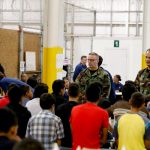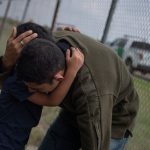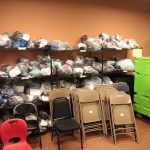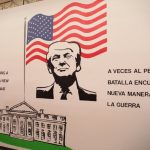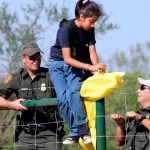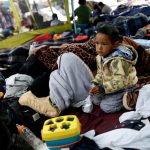Separating kids at borders
 Separating kids from parents at the border mirrors a ‘textbook strategy’ of domestic abuse, experts say — and causes irreversible, lifelong damage
Separating kids from parents at the border mirrors a ‘textbook strategy’ of domestic abuse, experts say — and causes irreversible, lifelong damage
By Kevin Loria From Business Insider
Under Attorney General Jeff Sessions’ new “zero-tolerance” immigration policy, everyone who attempts to cross the border — even those seeking asylum — are being prosecuted.
Because of the way that policy is enforced, almost 2,000 children have been separated from their parents in six weeks.
Experts, mental health groups, and human rights organizations all say this could cause serious, lasting harm to children and their parents.
Here’s how forced family separation affects people for the rest of their lives.
Babies ripped from parents’ arms. Tent cities. Mass trials. Suicides. Reports about what’s happening to children and families who arrive at the US-Mexico border have shocked many, from White House reporters to conservative religious leaders.
A Honduran woman told attorneys that her daughter was pulled from her as she was breastfeeding. After being separated from his wife and 3-year-old son, a Honduran man took his own life in a Texas jail cell.
Colleen Kraft, the president of the American Academy for Pediatrics, recently described seeing a blotchy-faced toddler sobbing and pounding on a playmat, terrified because she’d been forcibly separated from her mother.
“We knew what was wrong, but we were powerless to help,” Kraft wrote.
At issue in these accounts is a policy enacted by the US Department of Homeland Security and Department of Justice, which Attorney General Jeff Sessions has described as “zero tolerance.”
US authorities are now detaining and prosecuting anyone who attempts to cross the border illegally — even those seeking asylum because they’re fleeing violence, some of whom are being blocked from reaching official ports of entry. Within families, the parents are charged with a crime but children are not, which leads them to be separated. Almost 2,000 children were taken from their families between April 19 and May 31 as a result of the policy. In some cases, the kids are too young to speak.
Sessions described this policy as a deterrent. “If you are smuggling a child, then we will prosecute you, and that child will be separated from you as required by law,” he said in a speech to law-enforcement officials in Scottsdale, Arizona. “If you don’t like that, then don’t smuggle children over our border.”
But this policy could cause irreversible harm and psychological damage for the rest of people’s lives, according to experts. Some consequences could even be passed on to future generations.
Forced family separation has been condemned as harmful, inhumane, and counter to accepted human rights by many groups, including the American Academy of Pediatrics, the American Psychiatric Association, and the United Nations human rights office.
“The administration’s policy of separating children from their families as they attempt to cross into the United States without documentation is not only needless and cruel, it threatens the mental and physical health of both the children and their caregivers,” the American Psychological Association said in a statement.
‘A problem of the government’s own making’
There are more than 10,000 unaccompanied children in US facilities and detention centers right now; some have been separated from their parents, while others arrived at the border alone. But Sessions’ zero-tolerance approach means that for the first time, an official policy calls for the splitting of families. According Homeland Security numbers obtained by The Associated Press, officials had separated 1,995 children from 1,940 adults by the end of May.
By now, more than 2,000 kids — likely freshly traumatized — have probably been added to the US’ already overwhelmed system for dealing with young immigrants.
Almost 1,500 boys between the ages of 10 and 17 have been crammed into one shelter inside a former Walmart in Brownsville, Texas. Jacob Soboroff, a reporter who visited that facility, described the boys as “incarcerated” because they were eating in shifts, had just 40 square feet of living space, and spent only two hours outside each day. The Trump administration is currently building “tent cities” near the border to hold the many undocumented kids who arrive in the US.
“Before, their cases would have been dealt with as a family,” Megan McKenna, senior director of communications at the nonprofit Kids in Need of Defense (KIND), told Business Insider. “It’s a problem of the government’s own making.”
This isn’t the first time families have been separated at the border. But now, doing so is the rule, not the exception. After families are separated, parents get dealt with by Immigration and Customs Enforcement (ICE), as they are being charged with a crime. Since the children are not charged, their cases get managed by the Office of Refugee Resettlement (ORR). In many cases, families who get separated aren’t given any information about where other family members are being held or how to contact each other.
“They just have no understanding of what’s happening to them or when they’re going to see their family again, and we can’t tell them when they’re going to see their parents again because we don’t know either,” said McKenna, whose organization tries to match children with attorneys. “It’s extraordinarily damaging to the child.”
‘Irreversible harm’
Jodi Berger Cardoso, an assistant professor of social work at the University of Houston, researches the effects of trauma on immigrants and their children.
“What they are doing to these children and parents is inhumane,” Cardoso told Business Insider. “If we just look at the research evidence, anyone can see that these tactics will have long-term consequences for children and families.”
Dr. Lisa Fortuna, medical director for child and adolescent psychiatry at Boston Medical Center, told Business Insider that “in situations of stress, the only way that children can cope is if they have a caregiver with them that’s taking care of them and that’s there to protect them.”
The removal of a caregiver can create acute distress that harms a child’s ability to cope and self-soothe, which can lead to depression and post-traumatic stress disorder (PTSD). In vulnerable developing brains, that can be especially harmful.
“What we find from a neurobiological sense is that the circuitry in the brain that is a fear response can be actually harmed,” Fortuna said. In other words, the parts of the brain that manage fear responses — the amygdala and hippocampus —develop differently in traumatized children.
That can alter their emotional experiences for the rest of their lives, Fortuna explained, and put a child “at higher risk for ongoing anxiety, depression, PTSD as they get older.” Those factors, in turn, hurt their future educational outcomes and sense of well-being, and can cause behavioral problems. For that reason, Fortuna wrote in an amicus brief for an ACLU case that family separation can cause “irreversible harm” for children.
Even when kids are separated from parents in a non-forceful way, research suggests those children have a higher risk of anxiety and depression.
Lessons from families of the past: multi-generational damage
Previous times in history when families were separated have illustrated these long-lasting psychological consequences.
“Historically when things have happened like this — from the literature — when you have this accumulation of trauma and you break up families, you have a direct negative impact on the children, the caregivers, and potentially intergenerational bad effects,” Fortuna said.
The US and Canada have a long history of separating Native Americans from their families. Researchers have linked the experience of Native Americans who were pressured to relocate away from tribes and family groups in the 1950s to problems with substance abuse and depression. Depression and juvenile behavior issues even persisted through the next generation as well.
In Australia, as many as 100,000 children from the Aboriginal and Torres Strait Islander people were removed from their families from the late 1800s through 1960s and placed with white families or in government institutions to assimilate them into majority culture. Data shows that people who were forcibly separated from their families as children experienced significant, long-lasting negative impacts: they were almost twice as likely to be charged with a crime as adults, 60% more likely to have alcohol use disorders, and more than twice as likely to have gambling problems.
Surveys found that even the children of people who’d been separated from their parents in Australia had more than double the average risk of emotional and behavioral difficulties.
Using children to control parents mirrors domestic abuse behavior
Laurie Heffron, an assistant professor of social work at St. Edwards University in Austin, Texas, works with immigrants and women who have experienced domestic and sexual violence.
She said that using children to manipulate adults’ decisions — as Sessions’ policy is intended to do — “is an eerie mirroring” of a “textbook strategy of people who abuse their partners.”
In domestic abuse situations, one partner often uses control of children as a way to “manipulate their partner, maintain control over their partner, or coerce their partner,” Heffron said. “Except now it’s children being manipulated and being used as pawns to control a whole community of people, a whole population of people who are trying to seek safety.”
This is particularly troubling for Heffron, since a central motivation for many of the immigrant women she’s worked with has been to find a safe place to raise their children, away from violence inside or outside their home.
Compounded trauma
In addition to the lasting negative impacts of family separation, immigrant families detained at the border face three other sources of trauma that can compound the psychological damage.
First, many of these families have already suffered hardship in their home countries, which is what caused them to leave.
“Children are being persecuted by gangs, either through forced recruitment, extortion, and or violence,” Cardoso said. “Women have a high risk for interpersonal violence that includes physical and sexual violence.”
Second, many immigrants encounter violence and trauma on the dangerous journey to the US.
“On top of whatever reason people have left their homeland… are migration-related experiences that may be oftentimes negative, which could include physical or sexual abuse or violence or exploitation or human trafficking,” Heffron said.
Cardoso found in her research of one group of unaccompanied children (who hadn’t been forcibly separated from parents) that those kids had experienced an average of eight traumatic life events — a clinical category that includes experiences like kidnapping, sexual assault, and witnessing violent crimes. About 60% of those kids met the criteria for PTSD and 30% for depressive disorder. The average age in that sample was 14.
And third, jail-like detention can trigger “self-harm, suicidal ideation, suicide attempts, depression, traumatic stress, anxiety, et cetera,” according to Heffron.
“What we know about folks who’ve experienced trauma is they need to feel safe,” she said. “Currently we’re doing the opposite of that. Not only are people not feeling safe emotionally because they’re separated from their families, they’re oftentimes not feeling safe physically because of the conditions of detention. We also hear allegations and there are reports of physical maltreatment and sexual violence in immigrant detention centers.”
Are immigrants really being deterred?
As KIND has documented, the zero-tolerance policy is one of many aimed at making it harder for immigrant families to seek asylum in the US — and deter them from trying.
When White House Chief of Staff John Kelly was asked by NPR whether taking children from their parents to deter immigration was cruel, he responded: “I wouldn’t put it quite that way … The children will be taken care of — put into foster care or whatever. But the big point is they elected to come illegally into the United States and this is a technique that no one hopes will be used extensively or for very long.”
The research contradicts Kelly’s claim that the children will be fine, and it’s also unclear whether this policy works as a deterrent. So far, reports from the border indicate that it isn’t deterring immigrants, since many experts say that people fleeing violence in their home countries are continuing to do so.
“We’ve heard from families that have said they would rather risk the plight of coming to the United States and possibly being detained than face sure harm or even death in their home countries,” McKenna said. “It’s a policy that’s just not going to be effective because it’s not addressing the core reasons of why these families and these children are coming to the United States. It’s just this pervasive violence that’s perpetrated by the gangs and narcotraffickers which control communities.”
Family separation also violates the UN Convention on the Rights of the Child, which specifically states that “a child shall not be separated from his or her parents against their will.”
“I think we should be a society that understands that we need to take care of children. If they come to our borders and they are families, we can’t harm them,” Fortuna said. “We have to deal with policy and immigration issues, I understand that, but it cannot be policy that harms people directly, intentionally.”
IMAGES:
2014 detained migrant children
Detainees sleep and watch television in a holding cell where hundreds of mostly Central American immigrant children are being processed and held at the U.S. Customs and Border Protection Nogales Placement Center. Associated Press/Ross D. Franklin
caravan migrants
Members of a caravan of migrants from Central America enter the United States border and customs facility, where they are expected to apply for asylum. Reuters/Edgard Garrido
migrant child caravan
A child traveling with a caravan of migrants from Central America sits at a camp near the San Ysidro checkpoint. Reuters/Edgard Garrido
border migrants
AP Photo/LM Otero, File
child migrant shelter brownsville texas
A mural depicting President Trump in the detention shelter in Brownsville, Texas Administration for Children and Families at the US Department of Health and Human Services
migrants us-mexico border
A four-year-old boy weeps in the arms of a family member as he and others were apprehended by border patrol agents after illegally crossing into the US from Mexico near McAllen, Texas, May 2, 2018. Reuters/Adrees Latif
child migrant shelter brownsville texas
Supplies are stored at a Brownsville shelter where child migrants are kept. Administration for Children and Families at the US Department of Health and Human Services
For more on this story go to: http://www.businessinsider.com/psychological-effects-of-separating-immigrant-kids-and-parents-2018-6

